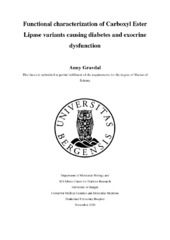Functional characterization of Carboxyl Ester Lipase variants causing diabetes and exocrine dysfunction
Master thesis
Permanent lenke
https://hdl.handle.net/1956/15382Utgivelsesdato
2016-11-21Metadata
Vis full innførselSamlinger
Sammendrag
The digestive enzyme carboxyl ester lipase (CEL) is mainly expressed in the acinar cells of the pancreas. We have previously identified disease-causing mutations in a variable number of tandem repeats (VNTR) domain, localised in the last exon of the CEL gene. Single base deletions (DEL1 or DEL4) in the VNTR lead to frameshifts and a truncated C-terminal of the CEL protein. Patients with these mutations suffer from exocrine pancreatic dysfunction and diabetes. In addition, a copy number variant of the CEL gene (CEL-HYB) with only 3 VNTR repeats has shown to be a novel risk factor for chronic pancreatitis. In this study, we wanted to further explore the role of the C-terminal domain of CEL in human pancreatic disease. We aimed to investigate the functional properties of not only previously characterized pathogenic variants, but also CEL variants identified in healthy controls. We also wanted to investigate whether a C-terminal epitope-tag could have an impact on our CEL protein studies. In HEK293 cells, we found that the expression and secretion of CEL variants varied with VNTR length and composition. Both pathogenic and normal CEL variants were observed in lysate and in insoluble fractions of the cell. However, secretion of the disease-causing variants was reduced compared to secretion of the normal protein. When comparing CEL variants with and without tag, we observed a higher amount of untagged proteins intracellularly. Additionally, we found that several CEL variants induced apoptosis in HEK293 cells, but unexpectedly, some of these variants also led to increased cell viability. The CEL VNTR is known to be heavily O-glycosylated, which is thought to be important for proper folding, secretion and stability of the protein. Here, we obtained evidence that the three deletion variants (DEL1, DEL4 and DEL8), all with the same theoretical molecular mass (73 kDa) but different VNTR composition, are likely to contain different patterns of O-glycosylation. Furthermore, the variants differed in secretion with only the pathogenic proteins (DEL1, DEL4 and HYB) showing impaired secretion. We also confirmed that the pI increased from CEL-WT to CEL-DEL1 by isoelectric focusing (pI 5.1 and 9.5 respectively). In summary, we have shown that the cellular fate of CEL protein variants is influenced by the C-terminal of the protein. In addition, we found that epitope- tags most probably increase the solubility and stability of CEL proteins HEK293 cells, which may have led to an underestimation of the pathogenic effect of CEL-DEL1, CEL-DEL4 and CEL-HYB shown in previous studies.
